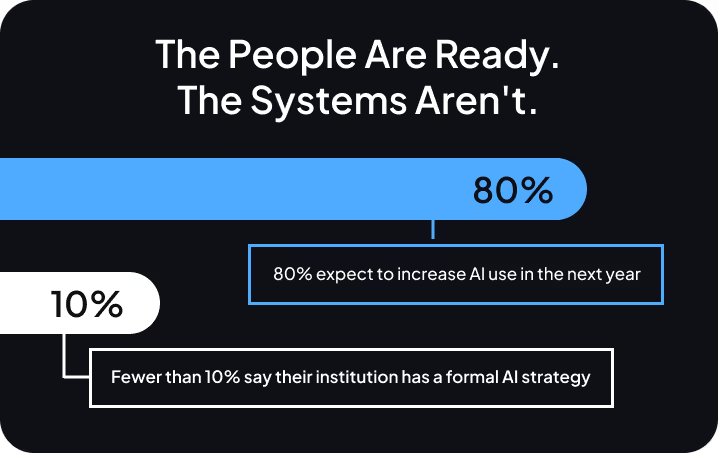Artificial intelligence in higher education is no longer a “what if.” It’s already showing up in the daily work of admissions, marketing, communications, and enrollment management.
But here’s the kicker: while individuals are leaning in, teams and institutions aren’t keeping pace.

- 80% expect to increase AI use in the next year
- Fewer than 10% say their institution has a formal AI strategy
For VPs and Directors of Enrollment, this isn't just an IT or marketing issue. It's a strategic imperative. The institutions that formalize their AI adoption now will outpace peers in personalization, efficiency, and applicant yield.
This blog digs into what the survey tells us about where we are today and points to what needs to happen next. And if you want to go further, we’ll be hosting a webinar to talk about how higher ed can move beyond experimentation into more strategic, powerful use of AI.
.png)
The Big Picture
AI adoption has moved fast in higher ed. Nearly everyone in the survey reported using AI in some way — most often for writing and editing content, brainstorming new ideas, or drafting communications.
- 74% of respondents are excited or curious about AI; only 3% are very concerned.
- Individual readiness outpaces team readiness. On average, people rated themselves nearly a full point higher than their teams on preparedness.
- Admissions and enrollment marketing are leading in personalization; marketing and communications lean more on content; enrollment management is turning to analytics and forecasting.
In other words: people are finding ways to make AI work. The challenge now is moving from individual, one-off wins to team-wide strategies.
Curious how ready you really are? Take our quick AI Readiness Quiz to find out your personal readiness level and get tailored tips for building your confidence and skills.
Barriers Are Real—But They’re Surmountable
Top concerns include:
- Lack of training (21%)
- Accuracy/trust (21%)
- Ethics/privacy (15%)
These concerns vary by persona. AI enthusiasts cite time; skeptics cite privacy. These barriers aren’t abstract. They show up in real conversations on our campuses. In fact, we’ve written before about the “personas” you’ll encounter when introducing AI (the Environmentalist, the Traditionalist, and the Pessimist) and how to address their concerns head-on. Read that post here.
As one participant put it:
“Getting leadership on board. AI is here to stay but way too many directors/deans are passive or scared to empower staff to use it.”
The point is, the obstacles aren’t about whether AI has potential. They’re about whether teams have the structure, skills, and trust to use it effectively.
Untapped Potential
The most striking insight from the survey is the gap between how AI is used today and where people see its real value.
- Efficiency is the white space. Only 18% currently use AI for speed and efficiency, but nearly half (49%) say it’s the biggest potential benefit. That’s the competitive edge waiting to be unlocked.
- Personalization is uneven. Almost half of admissions teams are personalizing student communications with AI. But in communications? Only 6%. There’s a lot of room for growth here. We’ve written before about how strong enrollment can mask weak digital experiences and how personalization is quickly becoming the real battlefield for institutions
- Operational AI is lagging. Private nonprofits are far behind publics and for-profits when it comes to automation and reporting.
Respondents are already experimenting beyond content creation:
“Created dashboards and modeling tools to help with Melt this year.”
“AI to facilitate my travel planning process… selecting which schools I visit and creating a schedule.”
These aren’t just nice-to-have experiments. They’re efficiency gains waiting to be scaled.
Four Moves for Enrollment Leaders Ready to Act
The message from the data is clear: the people are ready, but the teams aren’t. This is a leadership challenge.
Here are four moves institutions can make right now:
- Formalize Training & Policies
Don’t stop at “encouragement to explore.” Teams need structured learning and playbooks, not just permission. Having an AI ethics or generative AI policy correlates with higher readiness and broader adoption. - Empower Your High-Impact Practitioners
Every campus has “high-impact practitioners”: people who are already skilled, optimistic, and using AI in multiple ways. Empower them as internal champions to bring their peers along. - Shift from Creative to Operational AI
Early adoption has leaned heavily on brainstorming and drafting content. The next step is embedding AI into efficiency gains, reporting, and personalization at scale. That’s where real transformation happens. - Build Guardrails, Not Roadblocks
Policies don’t eliminate barriers, but they shift the conversation from if to how. As one respondent said:
“More guidelines on best practices and the importance of giving AI workable prompts/parameters.”
The Road Ahead
Higher ed professionals are not waiting on AI. They’re already using it to write, brainstorm, analyze, and experiment. But if institutions don’t close the readiness and policy gaps, they risk leaving that momentum untapped.
The survey data points to a clear opportunity: move from using AI occasionally to using it well, strategically, and institution-wide.
That’s where leadership, training, and shared playbooks come in.
Join the Conversation
The survey shows what’s happening now: experimentation, excitement, and uneven adoption. Now the opportunity is moving from quick wins to strategic, powerful use of AI that transforms how we recruit, communicate, and serve students.
Sign up for our upcoming webinar where we’ll go beyond the data and have a candid discussion on how higher ed can take AI from a helpful tool to a strategic advantage.
![[Report] AI in Higher Ed: Readiness, Barriers, and the Road Ahead](https://cdn.prod.website-files.com/64e9144d43e291ea775cf844/68dca889dc945261aa70673c_30%20-%20AI%20Adoption%20Survey.avif)



